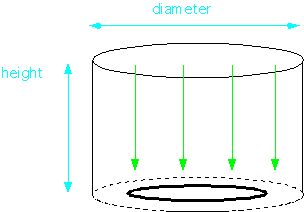Transport in HDP Reactors: Simplified Analysis
Consider a simple cylindrical idealized reactor, operating under typical HDP conditions:

Let us perform a transport analysis in the same manner as we have done for tube reactors and showerhead reactors. [We'll fix the gas flow at 300 sccm in order to maintain consistency with previous analyses.] Here are the results:

We see that the gas velocity, volumetric flow (and thus pumping speed required to support the flow) and diffusivities are all tremendously high, the result of very low pressure operation. The residence time is short despite the large chamber volume. In the absence of the plasma, the low pressures and short times would preclude most gas-phase reactions.
On the other hand, the ratio of the diffusion length to the system size is still about 1: at a constant molar flow, the Peclet number and Reynolds number are independent of pressure. Even at very low pressures, gas flow velocities play a role: convection and diffusion both help move things around.
However, we must tread carefully: the mean free path, while much smaller than the chamber as a whole, is comparable to the size of chamber features such as injectors, wafer edges, and wafer chucks. First-order corrections can be made to continuous fluid-flow models by e.g. allowing "slip": that is, by not requiring that tangential fluid velocities go to zero at solid surfaces. Accurate treatment of localized transport in an HDP reactor requires sophisticated and computationally expensive simulations (e.g. Monte Carlo approaches where actual molecular trajectories are followed).
Return to Tutorial Table of Contents
Book version of the CVD Tutorial
